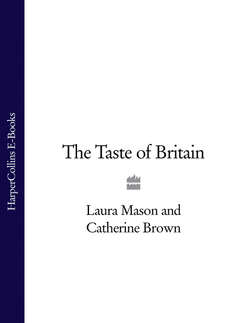Читать книгу The Taste of Britain - Hugh Fearnley-Whittingstall - Страница 203
HISTORY:
ОглавлениеBorage was probably introduced to Britain by the Romans, and has subsequently spread and naturalized on the chalk hills of southern England. There have been literary references to it since the thirteenth century. It was valued as a medicinal herb, and was made into cordials. Apothecaries considered it promoted cheerfulness and herbalists still use it to ease colds and throat complaints. The herb has also been used to decorate and flavour drinks. Dorothy Hartley (1954) quotes a recipe for claret cup from a Victorian magazine. This gives instructions for each glass to be flavoured with a sprig of borage, commenting on the unique flavour the herb gives and remarking, ‘On this account the pretty blue flowers can be had of every gardener during the picnic season, and it is grown under glass all the year round for the express purpose of flavouring claret-cup.’
Borage is grown in gardens on a small scale and produced in larger volumes by market gardeners and specialist herb growers. Several growers who specialize in herbs and salad vegetables, mostly in the southern and eastern part of England, grow borage as part of their mixed crop. Recently, it has been established as a field crop for the sake of the oil that can be extracted. Always recognized as a useful bee-plant, this modern development has allowed some apiarists to produce monofloral borage honey.
The flowers are used to garnish summer drinks, especially Pimm’s and claret cups. They are also added alone, or with other edible flowers such as nasturtiums, pot marigolds, chive flowers and heartsease, to salads; the leaves can be added too, if chopped finely. It is also used to flavour vinegars. The seeds can be used for the extraction of oils for food supplements. Until very recently, it was possible to buy borage flowers candied with sugar, although it appears that no-one makes these at present.
Alkanet, a related plant with similar leaves but smaller, rounder flowers is sometimes mistaken for borage; it is edible, although the applications are medicinal rather than culinary.
